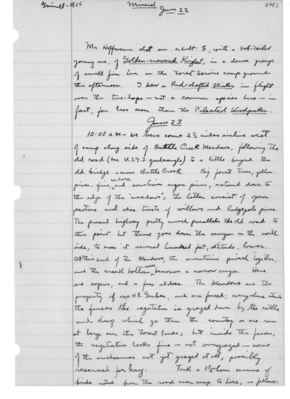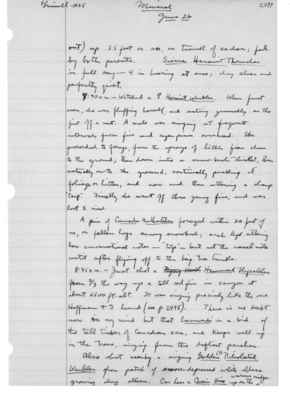Pages That Mention canyon
1925: Joseph Grinnell's field notes
S2 Page 4
Collector: Grinnell - 1925 Location: Lassen Section Date: June 12, 1925 Page Number: 2460
slopes of Inskip Hill); Calif. Woodpecker; Nuttall Woodpecker; Calif. Purple Finch (very common and in full song here in the black oaks); Linnet (equally common and in full song); Western Tanager (one in full song, as I write); Cassins Vireo and Western Warbling Vireo (equally in evidence); Wood Pewee (common); Ash-Throated Flycatcher ( "buckaroo" song heard early in the morning from slopes of Inskip Hill; Black-Throated Gray Warbler (several singing males); Lutescent Warbler (one singing male) Western Lark Sparrow (several); Western Chipping sparrow (common and singing); Green-backed Goldfinch (singing birds almost continually within hearing); Wren-tit (heard song from bushy slopes of Inskip Hill; Valley Quail (sentinel call of male in distance); Plain Tit (one pair, in black oaks); Slender-billed Nuthatch (very common); Bullock Oriole (one heard); Morning Dove (several have flown past); The "stream" right here is now dry - all the water taken out for the ranches around Payne Creek P.O. But down below here a few rods a narrow canyon begins, cut down thru the lava cap, and there, there are potholes with water, the source, apparently, for the birds of these woods. Along the ravine are luxurious golden oaks, densely blooming syringia (Philadelphus), ash trees, etc. Up in the rocky walls are bushes of Cercis and Rhus Trilobata.
S2 Page 18
Collector: Grinnell - 1925 Location: Lassen Section (Brokeoff Mt.) Date: June 17, 1925 Page Number: 2471
feet up behind a curled up section of thin bark on a dead lodgepole pine of about 10 inches diameter; mounds of snow all about; adjacent trees, hemlocks and red firs. Bird comes with bill-full of insects, and I can see the usual mass of twigs under the open side of the lifted park. 2:45 p.m. - At about 7500 ft. alt.; off the trail to the west, in one of the heads of Martin Creek; a ledge of rock along the western wall of the canyon has broken off to form a long talus slide, rocks up to a yard or more in diameter. Here, as I hoped, I hear conies in the typical association for them. At the fast of the Talus apron the snow is just going, but a little grass is coming up; also among the lowermost rocks some stalks of red elderberry are showing leaf; out from the Talus are mats of the prostrate arctostaphylos nevadensis; up along the ledges I can see clumps of red cherry and chinquapin; the trees about are red fir. I hear a Rock Wren singing ventriloquially from the rim-rock, which is well provided with crevices and caverns. This may prove to be the westernmost station for conies in the Lassen "section." 3:50 p.m. - Down to about 600-foot level, having come thru willowy meadows, with the grass barely above the earth, yet bands of restless cattle already run onto them, to keep them grazed and trampled down and the willows browsed up to 5 feet or so, and no chance for young shoots to start.
S2 Page 38
Collector: Grinnell - 1925 Location: Mineral Date: June 22 Page Number: 2492
Mr. Hoffmann shot an adult male, with a bob-tailed young one, of Golden-crowned Kinglet, in a dense group of small fir here on the Forest Service camp ground this afternoon. I saw a Red-shafted Flicker in flight over the tree-tops - not a common species here - in fact, far less seen than the Pileated Woodpecker.
June 23 10:00 a.m. - we have come 2 1/2 miles airline west of camp along side of Battle Creek Meadows, following the old road (see U.S.G.S quadrangle) to a little beyond the old bridge across Battle Creek. Big forest trees, yellow pines, fir, cedars, and sometimes sugar pines, extend down to the edge of the "meadows"; the latter consist of open pasture and also tracts of willows and lodgepole pines. The present highway pretty much parallels the old road to this point but thence goes down the canyon on the north side, to cross it several hundred feet, altitude, lower. At this end of the Meadows, the mountains pinch together, and the creek bottom ^soon becomes a narrow canyon. Here are aspens, and a few alders. The Meadows are the property of one W. L. Gerber (?), and are fenced; everywhere astride the fences the vegetation is grazed down by the cattle and sheep which go thru [sic] the country or are seen at large over the forest lands; but inside the fences, the vegetation looks fine - not overgrazed - some of the enclosures not yet grazed at all, possibly reserved for hay. Took a 1 1/2 hour census of birds notes from the road near camp to here, as follows:
S2 Page 43
Collector: Grinnell - 1925 Location: Mineral Date: June 26 Page Number: 2497
out) up 35 feet or so, on trunk of cedar; fed by both parents. Sierra Hermit Thrushes in full song - 4 in hearing at once, day clear and perfectly quiet.
7:40 a.m. - Watched a [female symbol] Hermit Warbler. When first seen, she was fluffing herself, and attacking generally as tho just off a nest. A male was singing at frequent intervals from fir and sugar pines overhead. She proceeded to forage, from the sprays of little fir close to the ground; then down into a snow-bush thicket, then actually on to the ground, continually picking at foliage or litter, and now and then uttering a sharp "tsip." Finally she went off thru young firs, and was lost to view.
A pair of Canada Nuthatches foraged within 20 feet of us, on fallen logs among snowbush; each kept uttering low conversational notes "Tiys" - but not the nasal note until after flying off to the big tree trunks.
8:45 a.m. - Just shot a Pygmy Nuth Hammond Flycatcher from 2/3 the way up a all red fir in canyon at about 6500 ft. alt. It was singing precisely like the one Hoffmann & I heard (see p. 2495). There is no doubt now in my mind but that hammondi is a bird of the tall timber of Canadian zone, and keeps well up in trees, singing from the loftiest perches.
Also shot a singing Golden ^(?) Pileolated Warbler from batch of snow-depressed white alders growing along the stream. Can hear a Cassin Vireo up on the ^warmer ridge.
S2 Page 75
Collector: Grinnell - 1925 Location: To Mineral Date: July 25 Page Number: 2528
Last spec. no. 6292
Stu and I in the machine left Berkeley at 4 yesterday afternoon, slept on the "badlands" midnight to 4:45 a.m., left Red Bluff at 6:15 a.m. and reached the family camp above Mineral at 9:45 a.m. Notable along the highway within 12 miles below Red Bluff were the Yellow-billed Magpies, 2 to 6 or 8 in sight at once and very tame, on the ground or roadside fences with autos passing close by. At Dale's on Paine Creek, although 7:30 a.m., hardly any birds now singing; a Wood Pewee was drawling, and a Chat singing fitfully, more so than normally. Within a mile above Dale's, a Roadrunner sped ahead of us a little ways, then made off among the boulders. From Dale's clean up to the first yellow pines (at 3200 about) I was impressed by the numbers of Douglas Ground Squirrels and Jack Rabbits; numbers of partly grown young of each species were seen. Below (west of) Battle Creek Meadows along the highway up the north wall of the canyon about the bridge, I saw at least 8 Callospermophilus, one of them not over 1/3 grown. An adult was seen at the roadside close to the north side of the Meadows. This species seems to come down with the fir belt from the high mountain immediately to the north. Here at camp I am impressed by the quietness of the birdlife. Once in a while there is the broken song of a Fox Sparrow; and the Chickadee's "tee-tee, too, too" is heard; but




